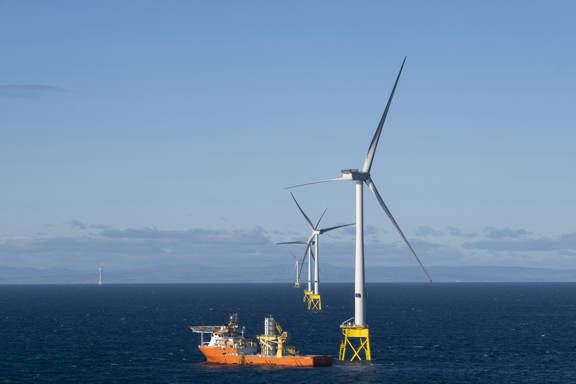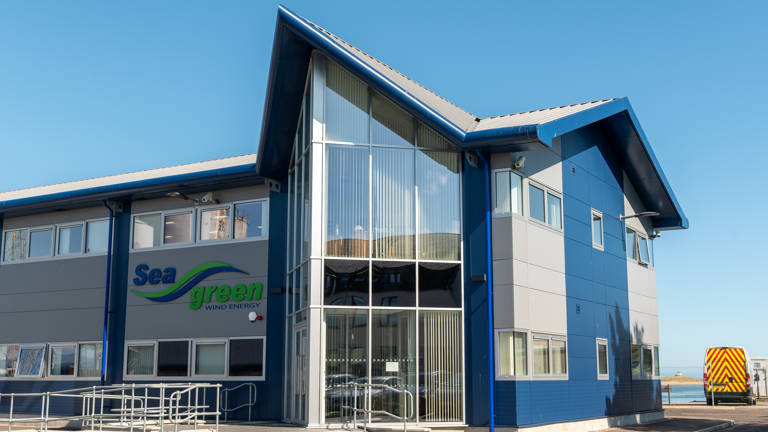Seagreen Offshore Wind Farm is harnessing the energy of the North Sea wind
Learn more about Scotland’s largest wind farm and how it’s supporting the move away from fossil fuels.

18 March 2024 | 4 minute read
Seagreen, a joint venture partnership between SSE Renewables and TotalEnergies, is Scotland’s largest and the world’s deepest fixed bottom offshore wind farm. The team behind it braved the extreme conditions of the North Sea to get the site up and running. Learn more about the benefits it’s set to deliver to Scotland’s economy and net zero ambitions.
SSE Renewables, part of Scottish-headquartered SSE plc, is a developer and operator of renewable energy generation. The company has several projects underway which are set to increase its renewable energy capacity to over 16 Gigawatts (GW) by 2032.
One of these projects is the Seagreen offshore wind farm. Located approximately 27 kilometres off the coast of Angus, Seagreen is Scotland’s largest windfarm and holds the record for having the world’s deepest fixed bottom foundations.
Even more impressive than this, though, are the benefits it’s set to deliver in the UK and beyond.
The scale of Seagreen
Each turbine at the Seagreen site has a hub height of 120 meters, supported by just under 100 meters of subsea foundation infrastructure. Instead of being drilled into the seabed, these enormous structures use a new and innovative type of foundation for offshore wind called a suction caisson. These have proven to be a huge success at the site, as they can be installed quickly and are particularly well suited to the ground conditions at Seagreen.
Now fully operational, the site has 114 turbines, each able to generate approximately ten megawatts (MW) of energy. In total, they will produce just over a gigawatt, enough to power approximately 1.6 million homes, displacing the equivalent carbon of removing two thirds of cars off the road in Scotland.
The ‘onshore heart’ of Seagreen is the base in Montrose, which will be the main control base for the wind farm’s life.
And while the base is supporting the Seagreen site to harness green energy, it’s also contributing to net zero ambitions itself. The facility is housed within a recycled prefabricated building – originally starting life in Aberdeen and then being moved and repurposed to its current location.

The future benefits of Scotland’s energy history
The North Sea is well known as a challenging environment, with extreme weather conditions. Constructing a site like Seagreen – which has been worked on year-round since its beginning – in the North Sea means tackling these challenges each day.
This is where Scotland’s rich history of working in conditions such as these, previously for oil and gas, is incredibly useful. Many of the skills are transferrable and the legacy of the established oil and gas industry in Scotland is paving the way for the energy transition. Much of the technology and expertise being used at Seagreen having previously been used for the oil industry.
One of the key contractors for Seagreen, Subsea 7 in Aberdeen, has an oil background which has helped to inform everything from the design to the construction of elements at Seagreen.
Sandie Lengden, Seagreen’s Senior Project Manager at the site, said:
“50 years of Scotland working on the North Sea – it’s new and innovative in its own way but we’re also taking a lot from the tradition and everything that’s come before.
“The skills that we have in Scotland, built up over the last fifty years, really sets us up for these projects. We’ve got the skills from the people – they know what they’re doing, they know how to deal with the weather challenges – and we also have the vessels and the capabilities that are up to the challenge.”

How Seagreen is supporting the Scottish economy
The benefits of the Seagreen site aren’t limited to energy. While the green benefit is great – the site is an excellent flagship for renewables – there are several other benefits.
Green jobs
During construction, Seagreen supported more than 400 jobs in Scotland, both through the project and external contracts.
Now at the end of the construction, the project has moved into its operational phase. From this point and for the lifetime of the project, it’s estimated that the Operations and Maintenance (O&M) Base in Montrose will support approximately 80 jobs, between the control room staff, company staff and Vestas, the turbine supplier and servicer with around 60 people working in two week shift rotations offshore on the purpose built Service Operations Vessel (SOV) the Edda Brint. Many of the direct roles at the O&M base have been filled with people from the area local to Montrose.
Economy
The Seagreen team estimates that the site will contribute approximately £2 billion to the UK economy, £1 billion of which will be focused on Scotland.
The site is also a key part of securing Scotland’s energy supply as the country moves away from fossil fuels. The hope is that it won’t only be beneficial for the planet, but it’ll help to drive down people’s bills, too.
Need some expert advice?
Our specialists are on hand to answer your questions and help your company on its sustainability journey.
-
Sign up to email updates
Stay up to date with the latest news, events and opportunities for your business.
